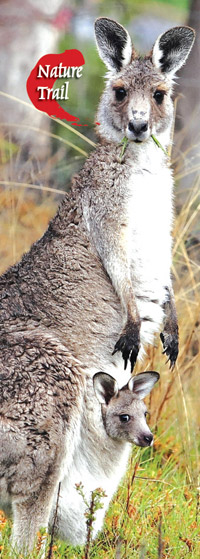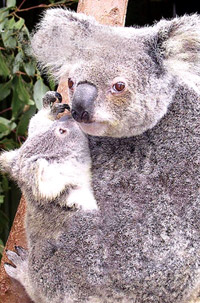Mammals
with pouches
|

A Kangaroo and joey |
Exotic, beautiful, strange and bizarre are some of the words we can
use to describe the numerous species belonging to the Animal Kingdom.
Each species with its unique features and characteristics never fail to
fascinate us. Animals are all beautiful in their own way and have a
special role to play in the cycle of life.
Today we like to introduce you to one such fascinating group of
animal, some of you may already be familiar with. They are members of
the mammalian family but have a unique physical attribute that sets them
apart from the rest of the mammals.
These mammals are classified as marsupials because they carry their
young around in a pouch called a marsupium. Most of the marsupials are
found in Australia and neighbouring islands with some living in South
America.
The Kangaroos are the best known marsupials but koalas, possums,
wombats, wallabies and bandicoots are also members of this group.
Did you know that the kangaroo babies or joeys are extremely small
when they are born, at an early stage of their development? As they are
not fully developed when the mother gives birth to them, these baby
marsupials are still blind, naked (meaning they have no fur on their
bodies) and very small in size.
In fact, youíll find it hard to believe that a baby kangaroo is less
than three centimetres long when itís born. However, though so small in
size and blind too, it is not helpless. It is strong enough to crawl up
its motherís furry stomach and climb into her warm, cosy pouch to get
the milk it needs to grow stronger.
|

A baby kangaroo(joey) in the pouch
A Koala baby |
Once it finds its way to the motherís pouch, the baby kangaroo which
is called a joey will feed on its motherís milk and not venture out for
the next 33 weeks. Even after its development is complete, and the joey
leaves the pouch to venture out, it returns to the pouch to feed or for
protection at the first sign of danger, for several months more.
There are two types of giant kangaroos, the Red Kangaroo and the Grey
Kangaroo and several smaller species of kangaroos such as the Tree
kangaroo and the Wallaby.
The Wallaby is a graceful small kangaroo of which there are several
species in Australia. Larger wallabies are about a metre tall while the
smaller, short-tailed wallabies are the size of hares. Tree kangaroos
are even smaller - about 70 centimetres. The wallaroos are medium sized
kangaroos which are found in the grasslands of Australia, Tasmania and
Papua New Guinea. They are also called the Mountain Kangaroos.
Another Australian mammal with a pouch is the Koala which is often
mistakenly refereed to as a koala bear, for its bear-like appearance.
Koalas are not bears - they are marsupials. They are cute and cuddly
looking mammals that are endangered today, due to their selective diet;
they eat only the leaves of 12 species of eucalyptus gum trees. Loss of
habitat has led to a reduction of their favourite food.
The only aquatic marsupial, the Water Opossum also has a pouch with
an opening that can be tightened while in water. This helps to keep its
babies dry while it swims. The water opossum is a nocturnal animal which
is rat-like in appearance and grows to about 30 cm (12 in) in length. It
is found in Central and South America.
The Virginia Opossum is the only marsupial found in North America and
holds the record for being the quickest breeder among the mammals. It
has a pregnancy of just 8-13 days. The young weighing barelytwo
grams(0.01 oz), are also born blind and without any fur like most
marsupial babies.
They have to make the hard journey into their motherís pouch but as
they are not very strong more than a third of the infants die on the
way. The American Opossum gives birth to about 25 infants in one litter.
It has two litters annually.
|

A Koala and baby |
Discovered less than a century ago, the Marsupial Mole can be found
widely throughout Central and South America. Not more than 10-20 cm in
length, including its tail, the Marsupial Mole changes its behaviour
abruptly. It suddenly goes to sleep in the middle of frantic activity.
After dropping to sleep while rushing about it would wake up and
continue rushing about many minutes later.
|

Tree Kangaro
The Virginia Opossum |
The Thylacine is also another interesting animal with a pouch. It is
called the kangaroo in wolfís clothing and is believed to be extinct
today. It was the only carnivorous marsupial.
Wombats are also marsupial that are found in Australia and Tasmania.
Some of the species are plump with a small head and short legs and have
a bear-like appearance. As the wombat is an animal that stays
underground during the day it is constantly engaged in digging.
A pouch which opens horizontally in the front like that of the
kangarooís is not practical because dirt could get into it when digging.
So, the wombatís pouch opens at the rear instead.
The Marsupial Mouse similar in size to mice and rats is found in
Australia. It has strong hind legs like those of a kangaroo.Another
animal that belongs to the group of mammals with pouches is the
Australian Echidna or the Spiny Anteater.
It is a strange animal and even though it is not a typical marsupial,
being classified as a montremes, it has a pouch like most marsupials.
However, it does not give birth to live young; instead it lays a
soft-shelled egg, like a reptile and breeds it in the pouch.
When we think of marsupials, we are of the view that all marsupials
have pouches. It is not so. There are a few animals such as the Shrew
Opossum and Numbat without a pouch. The numbatís young attach themselves
to the motherís nipples when they are born.
Fact file
* Marsupials are generally mammals with pouches. The word marsupial
is derived from the Latin word Marsupium which means pouch.
* Marsupials give birth to live young which are relatively under
developed or premature. The foetus is called a joey.
* The pouch or marsupium is a loose fold of skin that covers the
motherís nipples to protect the joey while it suckles and develops.
* Not all marsupials have pouches. A few donít have a pouch. Some
pouches open horizontally at the top while others open at the bottom.
The bilbyís pouch faces backwards.
* Over 200 species of marsupials are found in Australia and about
another 100 in America (Mostly Central and South.)
* Ingramís Planigale is the smallest living marsupial mammal. Found
in Western Australia it is about 2.3 - 3.5 inches long. |

